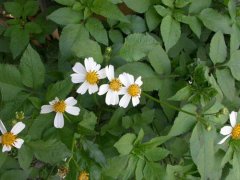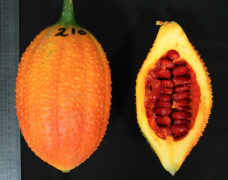Anthracnose, the main disease of papaya fruit, what causes anthracnose and how to control it?
Papaya (Carica papaya) is an attractive tree due to its tropical appearance and delicious edible fruit, large green berries mature yellow or orange. Some people call this tree and fruit papaya. When you see those depressed spots on papaya fruit, you may be dealing with papaya anthracnose. But through some cultural practices, papaya anthrax control in family orchards is not difficult. Continue reading about tips for treating papaya anthrax. What is papaya anthrax?
Papaya anthracnose is a serious fungal disease caused by the pathogen Colletotrichum gloeosporioides. Spores of the disease spread in rainy, wet periods, rain, splashes, plant-to-plant contact, and unsterilized tools. Spore growth and diffusion are most common when the temperature is between 64-77°F (18-25 ° C). Spores infect plant tissue and then lie dormant until harvest time. Anthracnose of papaya Gardeners living in Hawaii or other tropical to subtropical regions often grow tropical fruits such as papaya. In fact, in Hawaii, papaya fruit is grown commercially as a staple food and export crop, bringing in about $9.7 million annually.
Papaya anthracnose, however, is a serious papaya fruit disease that causes devastating crop losses every year. Your orchard may not be in the tropics, so you are more likely to develop anthrax on papayas in certain types of weather. Environmental conditions favourable to fungi include very high temperatures and high humidity. Under these conditions, control of papaya anthracnose is difficult. But humidity must be really high to affect papaya. When the relative humidity in your area is below 97%, spores of the fungus that causes anthrax usually do not germinate. They also need a lot of rain. In fact, raindrops splashing on the leaves are one of the ways papaya anthrax spreads. When the weather is dry, the fungus does not spread at all.
You can tell if you have anthrax on papaya by paying close attention to the fruit as it ripens. Papaya fruit begins with smooth green skin. However, as they mature, their skin turns yellow and their flesh softens. That's when anthrax appeared. If your tree has anthrax, you may see small brown to gray spots on papaya fruits or leaves. As these spots grow, they become larger sunken lesions with a water-soaked appearance. These spots are the initial symptoms of papaya anthracnose. Over time, you will see the center of the spot darken. When the fungus produces spores, the black dots turn pink and the underlying fruit becomes very soft. The disease can be present on harvested fruit, but does not appear until the fruit is stored or transported. Papaya anthracnose can also cause crop losses in bananas, mangoes, avocados, passion fruit and coffee in tropical or subtropical regions with high humidity and annual rainfall.
Treating papaya anthracnose Monitoring spots on ripe fruits will help you identify papaya anthracnose early. This means you can also start treating papaya anthrax as early as possible. Proper sanitation is essential in the event of disease. Early action means you can avoid chemicals when treating papaya anthrax. Use cultural controls such as harvesting ripe fruit quickly rather than leaving it on trees. You should also remove all dead leaves and fruit from the garden. Pay special attention to anyone who falls under the papaya tree. Cleaning up weeds or other garden debris can prevent papaya anthracnose from spreading from rain splashes and plant-to-plant contact. Also, always disinfect tools to prevent the spread of disease. Preventive fungicides may help control papaya anthracnose before papaya flowers appear or appear. Use fungicides containing copper hydroxide, mancozeb, azoxystrobin or bacillus. Spray orchards with fungicides every two to four weeks. You can also try planting resistant varieties such as Kapoho, Kamiya, Sunrise or Sunset to prevent disease.

- Prev

Is Xianfeng grass a Bidens bipinosa? what kind of plant is it? What is the specific effect of Xianfeng herbal medicine value
Xianfeng grass and Bidens bipinosa many people will admit mistakes, or regard them as a plant, in fact, it is not, these are two kinds of plants. Xianfeng grass can be seen everywhere, which belongs to the genus Asteraceae. In Taiwan, there are large flowers salty abundant grass, small flowers salty abundant grass and ghost needle grass.
- Next

Is Taiwan mandarin fruit a fruit? What are the nutritional values and uses of the fruit?
Is the wood nut a fruit? How would you like it? In order to popularize the original characteristic crop, the Taitung District Agricultural improvement Farm of the Committee of Agriculture of the Executive Yuan (hereinafter referred to as Taitung Field) conducted the "presentation on the Multi-Application of the original characteristic crop" and published the "original seed Wood".
Related
- A course of planting techniques and methods on how to grow carrots
- How to plant the latest tulips?
- Is it better to pick tea in the morning or in the afternoon? When is the best time for tea to be picked? what is the third or fifth tea?
- Launch Yuanxiao Happy combination Haocha + Tea Yuan healthy Taste
- Penghu Tourism "Fireworks 20 Parade with You"
- 2022 West Lake Happiness holds "Digital Revitalization Voucher" and draws iphone13 and laptop.
- Banqiao Fuzhou social houses are designed to change start-up combined with police elimination to create a safe and livable environment
- The convenient measure of "mechanical weeding" in Xinbei has been abused and the Agriculture Bureau has imposed heavy penalties on the illegal land consolidation.
- Changgeng University Joins Hands with Four Memory Factories to Rescue Memory Talent Shortage
- The list of Taiwan's top 100 MVP managers is listed by the Director-General of the Farmers' Association of Sanxia District.

